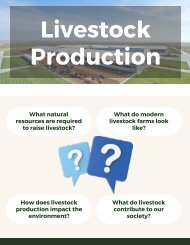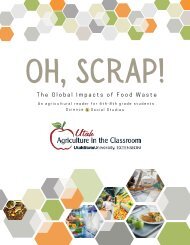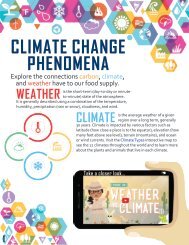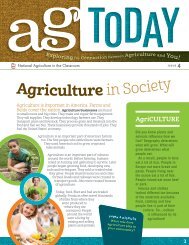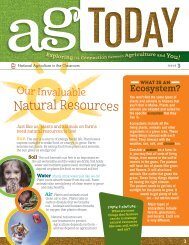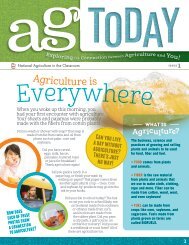From the Garden State to Your Plate
Children's book about New Jersey agriculture
Children's book about New Jersey agriculture
Create successful ePaper yourself
Turn your PDF publications into a flip-book with our unique Google optimized e-Paper software.
<strong>From</strong> <strong>the</strong> <strong>Garden</strong> <strong>State</strong><br />
<strong>to</strong> <strong>Your</strong> <strong>Plate</strong><br />
Farming Fruits and Vegetables in New Jersey<br />
A publication of <strong>the</strong> New Jersey Agricultural Society<br />
By Carolyn Taylor<br />
Art by Lauren Theis
New Jersey Agricultural Society<br />
1200 Florence Columbus Rd.<br />
Borden<strong>to</strong>wn, NJ 08505<br />
Copyright © 2019<br />
All rights reserved. No parts of this publication may be reproduced or<br />
transmitted in any form by any means, electronic or mechanical, including<br />
pho<strong>to</strong>copy, recording, or any information s<strong>to</strong>rage and retrieval system,<br />
without permission from <strong>the</strong> publisher.<br />
ISBN: 978-0-578-44291-4<br />
Special thanks <strong>to</strong> Caroline Etsch and Tracy Duffield of <strong>the</strong> New Jersey Farm<br />
Bureau Women’s Leadership Committee for <strong>the</strong>ir dedication <strong>to</strong> <strong>the</strong> publication<br />
of this book.<br />
Cover pho<strong>to</strong>graphs:<br />
Duffield’s Farm Market, Sewell, NJ; <br />
Specca Farms, Borden<strong>to</strong>wn, NJ; <br />
Title page pho<strong>to</strong>graph: A.T. Buzby Farm, Woods<strong>to</strong>wn, NJ;<br />
<br />
Beatrice Bee and New Jersey map by: Lore<strong>to</strong> Martin<br />
Nutritional information by: Elyse Yerrapathruni,<br />
Direc<strong>to</strong>r of Outreach & Events for Farmers Against Hunger
This book is dedicated <strong>to</strong> all<br />
<strong>the</strong> wonderful teachers in <strong>the</strong><br />
program<br />
who teach <strong>the</strong>ir students how <strong>the</strong>ir food is grown<br />
by giving <strong>the</strong>m <strong>the</strong> opportunity<br />
<strong>to</strong> plant and learn in a school vegetable garden.<br />
We are so proud of you!
That’s right, New Jersey’s nickname is<br />
<strong>the</strong> <strong>Garden</strong> <strong>State</strong> -cause of all <strong>the</strong><br />
wonderful food that is grown on New<br />
Jersey farms.<br />
Agriculture is ano<strong>the</strong>r word for<br />
farming. Agriculture is New Jersey’s<br />
third largest industry.<br />
Hi There!<br />
I am Beatrice, a -utiful honey bee! I am New Jersey’s<br />
official state insect. I am here <strong>to</strong> take you on a <strong>to</strong>ur of<br />
<strong>the</strong> fruits and vegetables that are grown in <strong>the</strong> <strong>Garden</strong><br />
<strong>State</strong>.<br />
Duffield’s Farm, Sewell, NJ; <br />
That may surprise you. Farming takes a lot of land, and New Jersey is a small<br />
state. In fact, of <strong>the</strong> 50 states in our country, only three states - Connecticut,<br />
Delaware, and Rhode Island - are smaller than New Jersey.<br />
Yet <strong>to</strong>day, <strong>the</strong>re are 9,000 farms in New Jersey where 100 different kinds of<br />
fruits and vegetables are grown.<br />
Farms are measured in acres. An<br />
acre is about <strong>the</strong> size of one<br />
football field. New Jersey’s farms<br />
cover 720,000 acres. That’s a lot<br />
of football fields!<br />
The value of crops grown in New<br />
Jersey each year is more than<br />
$1 billion. That’s a lot of money!
The two people in this eleva<strong>to</strong>r look<br />
very comfortable. The population of<br />
<strong>the</strong> eleva<strong>to</strong>r is not very dense!<br />
Truth <strong>to</strong>ld, you also wouldn’t think<br />
New Jersey is a good place for<br />
farming, -cause <strong>the</strong> state is very<br />
crowded. Nine million people live<br />
here. It is <strong>the</strong> most densely populated<br />
state in <strong>the</strong> country.<br />
What does that mean? It means<br />
that New Jersey has more people<br />
living here for each square mile than<br />
any o<strong>the</strong>r state.<br />
Here's <strong>the</strong> same eleva<strong>to</strong>r jammed<br />
with people - a very dense<br />
population!<br />
To understand density, picture an eleva<strong>to</strong>r with two people in it. The<br />
population of <strong>the</strong> eleva<strong>to</strong>r is not very dense. Then picture <strong>the</strong> same eleva<strong>to</strong>r<br />
crowded with people. The amount of space is <strong>the</strong> same, but <strong>the</strong> population in<br />
<strong>the</strong> eleva<strong>to</strong>r is very dense!<br />
If you divided New Jersey’s population equally and placed <strong>the</strong>m in<strong>to</strong> <strong>the</strong><br />
number of square miles in <strong>the</strong> state, <strong>the</strong>re would be 1,210 people in every<br />
square mile. If you did <strong>the</strong> same thing with <strong>the</strong> entire population of <strong>the</strong><br />
United <strong>State</strong>s, <strong>the</strong>re would be only 92 people in every square mile.<br />
Hillsboro Farms, Hillsborough,
Let’s take a look at where some of <strong>the</strong><br />
delicious crops that make New Jersey<br />
<strong>the</strong> <strong>Garden</strong> <strong>State</strong> are grown.<br />
This is a map of New Jersey showing 10 important fruits<br />
and vegetables grown here. You see that New Jersey is<br />
divided in<strong>to</strong> 21 counties. You can see that many counties, but<br />
not all, have farms that grow New Jersey’s 10 most important fruit and<br />
vegetable crops.<br />
On <strong>the</strong> map, you will also see <strong>the</strong> names of <strong>the</strong> 10 biggest cities in New Jersey.<br />
Look at <strong>the</strong> nor<strong>the</strong>astern corner of <strong>the</strong> map. Many of <strong>the</strong>se cities are located in<br />
<strong>the</strong> nor<strong>the</strong>astern part of <strong>the</strong> state, across <strong>the</strong> Hudson River from New York City.<br />
-cause <strong>the</strong>re are so many cities in this part of <strong>the</strong> state, <strong>the</strong>re is not much<br />
room for farming.<br />
Point <strong>to</strong> <strong>the</strong> northwestern corner of <strong>the</strong> map. There are fewer farms here<br />
because this area has many mountains and that land cannot be used for<br />
farming.<br />
This map shows <strong>the</strong> counties where <strong>the</strong>re are large farms of 100 acres or more<br />
that grow <strong>the</strong>se 10 fruits and vegetables. There are many smaller farms that<br />
this map does not show.<br />
Can you find your county on <strong>the</strong> map?<br />
Are any of New Jersey’s<br />
<strong>to</strong>p crops grown <strong>the</strong>re?
Map Key<br />
Sussex<br />
Bell Peppers<br />
Blueberries<br />
Corn<br />
Cranberries<br />
Passaic<br />
Paterson<br />
Clif<strong>to</strong>n<br />
Warren Morris Essex<br />
Newark<br />
Bergen<br />
Passaic<br />
Hudson<br />
Union City<br />
Cucumbers<br />
Elizabeth<br />
Union<br />
Jersey City<br />
Bayonne<br />
Peaches<br />
Hunterdon<br />
Somerset<br />
Soybeans<br />
Spinach<br />
Squash<br />
Mercer<br />
Tren<strong>to</strong>n<br />
Middlesex<br />
Monmouth<br />
Toma<strong>to</strong>es<br />
Ocean<br />
Camden<br />
Burling<strong>to</strong>n<br />
Gloucester<br />
Camden<br />
Salem<br />
Cumberland<br />
Atlantic<br />
N<br />
Are you ready? We are<br />
going <strong>to</strong> fly over <strong>the</strong> <strong>Garden</strong><br />
<strong>State</strong> <strong>to</strong> take a look at <strong>the</strong> fruits<br />
and vegetables that grow here!<br />
Cape May<br />
W<br />
E<br />
S
Blueberries<br />
We will -gin our <strong>to</strong>ur of New Jersey farms with<br />
blueberries, <strong>the</strong> official fruit of New Jersey and <strong>the</strong> state’s biggest<br />
crop! In fact, New Jersey is <strong>the</strong> fifth largest blueberry-growing state<br />
in <strong>the</strong> country.<br />
Blueberries grow on bushes in a woody area known as <strong>the</strong> Pine<br />
Barrens, which covers 1 million<br />
acres of land in Burling<strong>to</strong>n, Atlantic, and<br />
Ocean counties in <strong>the</strong> sou<strong>the</strong>rn part of <strong>the</strong><br />
state.<br />
Most crops won’t grow in <strong>the</strong> sandy, acidic<br />
soil of <strong>the</strong> Pine Barrens, but blueberries love<br />
it <strong>the</strong>re. They were growing wild in <strong>the</strong><br />
forests when <strong>the</strong> Lenape Native Americans<br />
<br />
lived on <strong>the</strong> land<br />
that later -came New Jersey. The Native Americans ate<br />
<strong>the</strong> berries and used <strong>the</strong>m for medicine, tea, and dyes.<br />
Elizabeth Coleman White invented<br />
blueberry farming in New Jersey in<br />
1910. <br />
<br />
There are two types of blueberry plants: highbush and<br />
lowbush. New Jersey farmers plant <strong>the</strong> highbush variety,<br />
which can grow 6-12 feet high. The berries from <strong>the</strong>se<br />
bushes are usually sold fresh.<br />
The lowbush variety of blueberries grows in Maine and<br />
Canada. These bushes only grow <strong>to</strong> about two feet high.<br />
The berries are smaller and are usually sold frozen or<br />
canned.<br />
Blueberry farming was actually<br />
invented in <strong>the</strong> New Jersey<br />
Pine Barrens in 1910 by a woman named Elizabeth<br />
Coleman White.<br />
-fore this time, people enjoyed <strong>the</strong> wild blueberries<br />
growing in forests, but <strong>the</strong>y couldn’t grow <strong>the</strong>m in <strong>the</strong>ir<br />
fields, which didn’t have <strong>the</strong> sandy, acidic soil that<br />
blueberries need.<br />
Blueberry bushes growing in fields of sandy soil. Merlino Bro<strong>the</strong>rs<br />
Farm, Hammon<strong>to</strong>n, NJ;
Elizabeth lived on a cranberry farm called<br />
Whitesbog in Browns Mills,<br />
Burling<strong>to</strong>n County. Cranberries also grow<br />
best in sandy, acidic soil. She got <strong>the</strong> idea<br />
<strong>to</strong> plant blueberries in -tween <strong>the</strong><br />
cranberry bogs on her farm. She contacted<br />
a botanist named Frederick Coleville who<br />
was doing research on blueberries for help<br />
with her idea.<br />
Elizabeth paid her neighbors <strong>to</strong> bring her<br />
blueberry bushes with <strong>the</strong> largest berries<br />
from <strong>the</strong> Pine Barrens forests. She<br />
Some blueberry farmers use a machine that moves over <strong>the</strong> bushes<br />
and shakes off <strong>the</strong> berries. Merlino Bro<strong>the</strong>rs Farm, Hammon<strong>to</strong>n, NJ;<br />
<br />
experimented with growing <strong>the</strong>m. Six years later, she was harvesting blueberries from<br />
her farm.<br />
Blueberries are harvested in June, July, and August. At most<br />
farms in New Jersey, <strong>the</strong> blueberries are picked by hand. At<br />
some very large farms, however, <strong>the</strong> berries are harvested<br />
by machines that move over <strong>the</strong> bushes, shaking <strong>the</strong> berries<br />
from <strong>the</strong> branches and dropping <strong>the</strong>m in<strong>to</strong> boxes.<br />
Blueberries are first green<br />
and <strong>the</strong>n turn blue.<br />
<br />
<br />
Name:<br />
Blueberry<br />
Antioxidants<br />
Vitamin C<br />
Vitamin K<br />
Blueberries are considered a<br />
superfood of nutrition! A serving<br />
of blueberries is stuffed with<br />
antioxidants like vitamin C, that<br />
help protect you from cancer and<br />
o<strong>the</strong>r diseases, as well as vitamin K,<br />
which is essential for blood<br />
clotting and healthy bones.<br />
Most New Jersey blueberries are picked by hand. Michael Cappuccio Farm,<br />
Hammon<strong>to</strong>n, NJ; <br />
What is a<br />
ghost’s favorite<br />
fruit?<br />
Boo-berries!
tOMATOES<br />
Toma<strong>to</strong>es -long on our <strong>to</strong>ur -cause Jersey <strong>to</strong>ma<strong>to</strong>es<br />
are famous for <strong>the</strong>ir sweet and juicy taste! The <strong>to</strong>ma<strong>to</strong> is<br />
<strong>the</strong> official vegetable of New Jersey and it is <strong>the</strong> state’s<br />
second largest crop. New Jersey ranks in <strong>the</strong> <strong>to</strong>p 10 states for <strong>to</strong>ma<strong>to</strong><br />
production.<br />
Toma<strong>to</strong> plants love hot wea<strong>the</strong>r, but<br />
in New Jersey <strong>the</strong>y cannot be planted<br />
outside in fields until <strong>the</strong> middle of<br />
May. So, most <strong>to</strong>ma<strong>to</strong> seeds are first<br />
planted inside greenhouses, where<br />
<strong>the</strong> small <strong>to</strong>ma<strong>to</strong> plants can get a<br />
head start growing in <strong>the</strong> warm air.<br />
Toma<strong>to</strong>es are planted in greenhouses like <strong>the</strong>se in early spring. Then<br />
<strong>the</strong>y are transplanted in<strong>to</strong> <strong>the</strong> field in <strong>the</strong> middle of May. Abma’s<br />
Farm, Wyckoff, NJ; <br />
The small <strong>to</strong>ma<strong>to</strong> plants from <strong>the</strong> greenhouse – called – are<br />
<strong>the</strong>n planted in <strong>the</strong> fields where <strong>the</strong>y grow until <strong>the</strong> <strong>to</strong>ma<strong>to</strong>es are ready<br />
<strong>to</strong> be eaten. When plants are grown in one place and <strong>the</strong>n moved <strong>to</strong><br />
ano<strong>the</strong>r, it is called .<br />
Toma<strong>to</strong> plants can grow up <strong>to</strong> six feet tall! When<br />
<strong>the</strong>se large plants are covered with <strong>to</strong>ma<strong>to</strong>es,<br />
<strong>the</strong>ir <strong>to</strong>ps get heavy, and <strong>the</strong>y bend <strong>to</strong>ward <strong>the</strong><br />
ground. Some farmers support <strong>the</strong>ir<br />
<strong>to</strong>ma<strong>to</strong> plants with stakes or cages.<br />
O<strong>the</strong>rs surround <strong>the</strong> plants with<br />
plastic so when <strong>the</strong> plants bend,<br />
<strong>the</strong> growing <strong>to</strong>ma<strong>to</strong>es do not lie<br />
on <strong>the</strong> ground. Toma<strong>to</strong>es are first<br />
green, and <strong>the</strong>n <strong>the</strong>y ripen <strong>to</strong> o<strong>the</strong>r colors.<br />
Why do Jersey <strong>to</strong>ma<strong>to</strong>es taste so good?<br />
<br />
On large farms in o<strong>the</strong>r states, <strong>the</strong> types of<br />
<strong>to</strong>ma<strong>to</strong>es grown are ones that won’t bruise easily when shipped a long<br />
distance. These <strong>to</strong>ma<strong>to</strong>es are picked when <strong>the</strong>y are green, and are often<br />
sent hundreds of miles <strong>to</strong> grocery s<strong>to</strong>res. While <strong>the</strong>se <strong>to</strong>ma<strong>to</strong>es travel well,<br />
<strong>the</strong>y don’t taste as good as Jersey <strong>to</strong>ma<strong>to</strong>es.
The types of <strong>to</strong>ma<strong>to</strong>es grown in New<br />
Jersey are chosen for <strong>the</strong>ir taste, not how<br />
well <strong>the</strong>y travel. Jersey <strong>to</strong>ma<strong>to</strong>es are<br />
picked by hand when <strong>the</strong>y are ripe and<br />
juicy. They are sold at nearby local<br />
markets where cus<strong>to</strong>mers can buy <strong>the</strong>m<br />
and eat <strong>the</strong>m immediately.<br />
Toma<strong>to</strong> harvest at Duffield’s Farm, Sewell, NJ; <br />
There are hundreds of types or <br />
of <strong>to</strong>ma<strong>to</strong>es. They can be large like a<br />
beefsteak <strong>to</strong>ma<strong>to</strong> or small like a cherry<br />
<strong>to</strong>ma<strong>to</strong>, and <strong>the</strong>y come in many colors:<br />
red, pink, orange, yellow, golden, white,<br />
black, and striped.<br />
<br />
Why did <strong>the</strong><br />
<strong>to</strong>ma<strong>to</strong> turn red?<br />
Because it saw<br />
<strong>the</strong> salad dressing!<br />
<br />
Name:<br />
Toma<strong>to</strong><br />
Lycopene<br />
Vitamin A<br />
Vitamin C<br />
Vitamin K<br />
Toma<strong>to</strong>es are full of vitamin A,<br />
which keeps your eyes healthy,<br />
and vitamins C and K. They also<br />
contain <strong>the</strong> cancer-fighting<br />
antioxidant lycopene.
BELL pEPPERS<br />
I -lieve I hear a bell telling me it’s time<br />
<strong>to</strong> talk about peppers! Bell peppers, that<br />
is! New Jersey ranks third in <strong>the</strong> country for<br />
growing bell peppers. These are <strong>the</strong> sweet<br />
peppers that are shaped like a bell and are<br />
usually green, red, or yellow.<br />
Bell peppers also can be orange, white, brown, and<br />
purple. Peppers -come sweeter and milder as <strong>the</strong>y<br />
ripen. Many peppers start out green and change<br />
color in <strong>the</strong> field as <strong>the</strong>y ripen.<br />
Small pepper plants growing in a field. The black plastic around <strong>the</strong>m keeps<br />
weeds from growing. <br />
Bell peppers are grown all<br />
over New Jersey, but most<br />
come from Gloucester,<br />
Cumberland, Salem, and<br />
Atlantic counties in <strong>the</strong><br />
sou<strong>the</strong>rn part of <strong>the</strong> state.<br />
Like <strong>to</strong>ma<strong>to</strong>es, most bell peppers are planted first in a greenhouse when it is<br />
<strong>to</strong>o cold for <strong>the</strong>m <strong>to</strong> grow outdoors. They are transplanted in<strong>to</strong> <strong>the</strong> field when<br />
<strong>the</strong> wea<strong>the</strong>r warms in May.<br />
Farmers pick bell peppers by hand.<br />
<br />
<br />
Bell peppers are often called “sweet”<br />
peppers -cause of <strong>the</strong>ir sweet taste.<br />
They are related <strong>to</strong> what we call “hot”<br />
peppers or “chili” peppers,<br />
but <strong>the</strong>y do not<br />
produce a substance<br />
called .<br />
Capsaicin is <strong>the</strong> stuff that will make your mouth feel like it’s on<br />
fire. Without capsaicin, bell peppers taste sweet, not spicy.<br />
Pepper plants at Duffield’s Farm, Sewell, NJ;
Can you find <strong>the</strong> green and red peppers<br />
growing on this plant?<br />
<br />
Why does <strong>the</strong> pepper that is in <strong>the</strong> shaker beside your<br />
salt have <strong>the</strong> same name as a bell pepper? Here’s <strong>the</strong><br />
s<strong>to</strong>ry. When Chris<strong>to</strong>pher Columbus sailed in 1492, <strong>the</strong><br />
king and queen of Spain asked him <strong>to</strong> bring back<br />
pepper from India. At that time, black pepper that<br />
grew on vines in India was a very popular spice and<br />
also very expensive.<br />
When Columbus landed in<br />
<strong>the</strong> Caribbean islands instead<br />
of India, he found <strong>the</strong> native<br />
people eating a new food –<br />
<strong>the</strong> hot pepper. He <strong>to</strong>ok this<br />
spicy vegetable back <strong>to</strong> Spain as a replacement for<br />
<strong>the</strong> expensive spice<br />
from India. This new<br />
vegetable quickly<br />
became very popular<br />
and was also called<br />
pepper.<br />
<br />
The pepper harvest at The Original Columbus Farm and Market<br />
in Florence, NJ; <br />
Name:<br />
Bell Pepper<br />
Vitamin A<br />
Vitamin B6<br />
Vitamin C<br />
To see Dr. Pepper!<br />
Where do<br />
vegetables go when<br />
<strong>the</strong>y are sick?<br />
Bell peppers are an excellent<br />
source of <strong>the</strong> vitamins A, C and<br />
B6, which helps keep your<br />
blood and your brain healthy.
Peaches at Fralinger Orchards, Bridge<strong>to</strong>n, NJ;<br />
<br />
-low. This is<br />
called <strong>the</strong> “chilling time.” The trees must have this time <strong>to</strong> chill out -fore<br />
fore<br />
making fruit again! New Jersey winters are<br />
cold enough <strong>to</strong> allow for this chilling rest,<br />
but <strong>the</strong> spring wea<strong>the</strong>r is usually not so cold<br />
that it will kill <strong>the</strong> fragile peach flower buds.<br />
There is a lot of work that goes in<strong>to</strong> growing<br />
peaches, and most of it must be done by<br />
hand. The trees must be pruned by skilled<br />
workers in <strong>the</strong> spring <strong>to</strong> thin out branches<br />
and remove many of <strong>the</strong> buds. A healthy<br />
peach tree may produce 10,000 flowers. Farmers must remove all but 1,000 of<br />
those flowers so so <strong>the</strong>y will have room <strong>to</strong> <strong>to</strong> turn in<strong>to</strong> healthy, large peaches. When<br />
<strong>the</strong> peaches are ripe, <strong>the</strong>y also must be picked by by hand.<br />
Flowering peach trees at Circle M Farms, Salem, NJ;<br />
<br />
The big s<strong>to</strong>ne or in <strong>the</strong> middle of a peach is <strong>the</strong> seed. But <strong>to</strong> grow a new<br />
peach tree, farmers don’t just plant <strong>the</strong> seeds. Farmers want <strong>to</strong> grow trees<br />
that have <strong>the</strong> juiciest and largest fruit and that can survive bad wea<strong>the</strong>r,<br />
disease, and insect attacks. So most new fruits are grown with a process<br />
called .
Harvesting peaches by hand at Duffield’s Farm, Sewell, NJ;<br />
<br />
s<br />
<br />
soaking up <strong>to</strong>o much water,<br />
which would make it rot. O<strong>the</strong>rs think <strong>the</strong> fuzz protects peaches from<br />
insects who don’t like <strong>to</strong> walk over <strong>the</strong> rough skin.<br />
Fiber<br />
Vitamin A<br />
Vitamin C<br />
Some people don’t like <strong>the</strong> ticklish feel of peach fuzz.<br />
Those people can eat nectarines, which are a<br />
type of peach with smooth skin.<br />
New Jersey peaches are sold fresh all<br />
over <strong>the</strong> eastern part of <strong>the</strong> United<br />
<strong>State</strong>s and in Canada.<br />
Did you hear <strong>the</strong><br />
joke about <strong>the</strong><br />
peach?<br />
It was<br />
pit-iful!<br />
Peaches are packed with vitamins A<br />
and C. They also provide fiber that<br />
helps you digest your food.
cranberries<br />
-sides blueberries, <strong>the</strong> Pine<br />
Barrens are also home <strong>to</strong><br />
cranberry farms. New Jersey<br />
ranks third in <strong>the</strong> country -hind<br />
Massachusetts and Wisconsin for producing<br />
cranberries.<br />
<br />
Do you think <strong>the</strong> cranberry flower looks like a crane? Early settlers<br />
called this fruit “craneberries.” Pine Island Cranberry Farm,<br />
Chatsworth, NJ; <br />
Cranberries grow on vines in an area of soft, wet,<br />
swampy ground called a . Cranberries are a<br />
tart fruit. They have a sharp taste that is not as<br />
sweet as o<strong>the</strong>r fruits. That’s why cranberries are<br />
rarely eaten raw. They are usually mixed with<br />
sugar in<strong>to</strong> cranberry juice or cranberry sauce, or<br />
or dried with sugar added.<br />
Early American settlers called this round, red fruit “craneberry” -cause <strong>the</strong>y<br />
thought <strong>the</strong> plant’s flowers looked like a crane. A crane is a bird with a long<br />
neck and long legs that searches for food by wading in rivers and ponds. The<br />
name was later shortened <strong>to</strong> cranberry.<br />
Cranberries float! Each cranberry has four<br />
small pockets of air inside so it can<br />
float, just like <strong>the</strong> tube you fill with air <strong>to</strong><br />
float on in a swimming pool.<br />
When it’s time <strong>to</strong> harvest <strong>the</strong> cranberries,<br />
farmers flood <strong>the</strong> bogs with water. They<br />
use a machine called a water reel -- its<br />
nickname is “<strong>the</strong> eggbeater” -- <strong>to</strong> churn<br />
<strong>the</strong> water and pull <strong>the</strong> cranberries off <strong>the</strong><br />
vines.<br />
Farmers use a machine nicknamed “<strong>the</strong> eggbeater” <strong>to</strong> knock <strong>the</strong><br />
berries from <strong>the</strong> flooded cranberry plants.<br />
Pine Island Cranberry Farm, Chatsworth, NJ; <br />
The berries float <strong>to</strong> <strong>the</strong> surface. Farmers wade in<strong>to</strong> <strong>the</strong> bogs and ga<strong>the</strong>r <strong>the</strong><br />
cranberries <strong>to</strong>ge<strong>the</strong>r with floating booms. The berries are <strong>the</strong>n lifted or<br />
pumped in<strong>to</strong> trucks.
Harvested cranberries are poured in<strong>to</strong> a bin for cleaning.<br />
Blowers dry <strong>the</strong> cranberries and remove <strong>the</strong> leaves.<br />
Pine Island Cranberry Farm, Chatswoth, NJ ;<br />
<br />
Ripe cranberries bounce! Farmers remove<br />
unripe cranberries from ripe cranberries by<br />
bouncing <strong>the</strong>m on a machine called a<br />
separa<strong>to</strong>r or “bounce board.” The ripe<br />
cranberries bounce down <strong>the</strong> machine. This<br />
machine was invented in <strong>the</strong> 1840s by John<br />
“Peg Leg” Webb, New Jersey’s first cranberry<br />
farmer. John s<strong>to</strong>red his cranberries on <strong>the</strong><br />
second floor of his barn. Because he had a wooden leg, John could not carry<br />
<strong>the</strong> barrels of cranberries down <strong>the</strong> stairs. So, he spilled <strong>the</strong> cranberries down<br />
his barn stairs instead. John noticed that <strong>the</strong> ripe berries bounced down <strong>the</strong><br />
stairs and <strong>the</strong> unripe cranberries stayed at <strong>the</strong> <strong>to</strong>p.<br />
Cranberry sauce was invented by a<br />
New Jersey farmer named<br />
Elizabeth Lee in 1917.<br />
Farmers wade in<strong>to</strong> <strong>the</strong> flooded cranberry bog and ga<strong>the</strong>r <strong>the</strong><br />
cranberries with a floating boom. Lee Bro<strong>the</strong>rs, Inc. cranberry farm,<br />
Chatsworth, NJ; <br />
Name:<br />
Cranberry<br />
Antioxidants<br />
Fiber<br />
Manganese<br />
Vitamin C<br />
What’s <strong>the</strong><br />
difference<br />
between a pirate<br />
and a cranberry<br />
farmer?<br />
A pirate buries his<br />
treasure, but a cranberry<br />
farmer treasures his<br />
berries.<br />
Cranberries contain many<br />
disease-fighting antioxidants<br />
and are an excellent source of<br />
vitamin C, dietary fiber, and<br />
manganese, which is a mineral<br />
essential for growth and metabolism<br />
(breaking down foods for energy).
sweet corn<br />
Look out -low, I see fireworks! No Fourth of July picnic in<br />
New Jersey would be <strong>the</strong> same without sweet corn on <strong>the</strong> cob!<br />
New Jersey farmers harvest about 60 million pounds of sweet<br />
corn each year. Salem, Burling<strong>to</strong>n, and Gloucester are <strong>the</strong> three counties that<br />
grow <strong>the</strong> most sweet corn.<br />
People use many unusual words when <strong>the</strong>y<br />
talk about corn. The seeds are called .<br />
They are attached <strong>to</strong> a long, round, woody<br />
. A typical cob can hold 800 corn kernels.<br />
We call a corn cob with <strong>the</strong> seeds attached an<br />
of corn.<br />
The corn seeds or kernels are protected by a<br />
leafy covering<br />
called a . To eat <strong>the</strong> seeds, you must remove<br />
<strong>the</strong> husk. When you remove <strong>the</strong> husk, you <br />
<strong>the</strong> corn. So if your mom tells you <strong>to</strong> get <strong>the</strong><br />
corn ready <strong>to</strong> eat, you can say, “Aww, shucks!”<br />
<br />
Sweet corn can be be white, yellow, or “bi-color”<br />
-- a mix of white and yellow.<br />
Unlike most vegetables, corn is not pollinated<br />
by bees or o<strong>the</strong>r insects. Corn is a grass plant<br />
that is pollinated by <strong>the</strong> wind.<br />
A corn plant has male and female parts. The<br />
male part, called <strong>the</strong> tassel, grows up from <strong>the</strong><br />
very <strong>to</strong>p of <strong>the</strong> plant and looks like a little tree<br />
with branches that are covered by sticky pollen.<br />
The tassels at <strong>the</strong> <strong>to</strong>p are <strong>the</strong> male parts of <strong>the</strong> corn<br />
plant. The silks in <strong>the</strong> middle are <strong>the</strong> female parts.<br />
Spring Brook Farms, Elmer, NJ; <br />
An ear of corn is actually <strong>the</strong> flower, and <strong>the</strong> corn’s female parts are <strong>the</strong> silky<br />
strands you can see growing out of <strong>the</strong> ears. In order for <strong>the</strong> plant <strong>to</strong> be
pollinated and produce corn kernels, <strong>the</strong> wind must blow pollen from <strong>the</strong><br />
tassels at <strong>the</strong> <strong>to</strong>p of <strong>the</strong> plant on<strong>to</strong> <strong>the</strong> silks in <strong>the</strong> ears. To get a corn<br />
cob full of kernels, each individual<br />
silk needs <strong>to</strong> be pollinated with<br />
pollen from <strong>the</strong> tassel.<br />
Some farmers first plant sweet corn<br />
seeds in <strong>the</strong>ir fields in late March.<br />
They <strong>the</strong>n cover <strong>the</strong> seeds in plastic<br />
<strong>to</strong> protect <strong>the</strong> tiny plants from <strong>the</strong><br />
Some farmers pick sweet corn by hand.<br />
Duffield’s Farm, Sewell, NJ; <br />
cold. O<strong>the</strong>r farmers plant a cool-wea<strong>the</strong>r variety of sweet corn in April. This is<br />
<strong>the</strong> corn that is ready <strong>to</strong> eat by <strong>the</strong> Fourth of July.<br />
After that, farmers plant more corn seeds every week, so that sweet corn on<br />
<strong>the</strong> cob is available <strong>to</strong> eat in<strong>to</strong> <strong>the</strong> fall. This is called planting.<br />
Some farmers harvest sweet corn by hand and some harvest <strong>the</strong> corn with<br />
a machine that strips <strong>the</strong> ears of corn<br />
from <strong>the</strong> plant.<br />
<br />
Why should you never<br />
tell secrets in a corn<br />
field?<br />
Because<br />
<strong>the</strong>re are<br />
ears all<br />
around!<br />
Sweet corn is different from field corn.<br />
Sweet corn is harvested when <strong>the</strong><br />
kernels are soft, making <strong>the</strong>m perfect<br />
for people <strong>to</strong> eat. Field corn is harvested<br />
later, when <strong>the</strong> kernels are dry and hard.<br />
This corn is fed <strong>to</strong> cows, chickens, pigs,<br />
and turkeys.<br />
Name:<br />
Sweet Corn<br />
Fiber<br />
Lutein<br />
Zeaxanthin<br />
Sweet corn is loaded with<br />
lutein and zeaxanthin, two<br />
phy<strong>to</strong>chemicals that promote<br />
healthy vision. A medium-sized ear<br />
of corn also offers a helpful threegram<br />
dose of dietary fiber.
soybeans<br />
Did you ever eat something made from soybeans? You<br />
may not know it, but I -lieve <strong>the</strong> answer is yes! Soybeans<br />
are packed with protein, more than any o<strong>the</strong>r bean.<br />
-- people who do not eat meat – often eat soy for<br />
protein.<br />
Soybeans are frequently made in<strong>to</strong> a dish that looks like soft<br />
cheese called , but <strong>the</strong>y are also made in<strong>to</strong> milk, flour, oil,<br />
and sauce. You can find soy in salad dressings, candy bars,<br />
frozen food, soup, crackers, hot dogs, and cereals. Raw<br />
soybeans are called .<br />
Soybeans are one of New Jersey’s <strong>to</strong>p crops and are grown<br />
all over <strong>the</strong> state. Most of <strong>the</strong> state’s soybean crop is shipped<br />
out of New Jersey <strong>to</strong> be made in<strong>to</strong> many different food<br />
products. Soybeans are also made in<strong>to</strong> meal that is fed <strong>to</strong> chickens, pigs, and<br />
cows. Soy is used <strong>to</strong> make shampoo, skin cream and makeup, candles, crayons,<br />
and household cleaners, as well as printing ink.<br />
Soybeans; <br />
Soybeans and all o<strong>the</strong>r beans<br />
are a type of plant called a<br />
. The word is<br />
pronounced lay-goom.<br />
Lentils, peas, and peanuts<br />
are also legumes.<br />
One of <strong>the</strong> most important<br />
nutrients for plants is called<br />
. There is a lot of<br />
A field of soybeans at Simonson Farms, Cranbury, NJ; <br />
nitrogen in <strong>the</strong> air around us, but most plants cannot get nitrogen from <strong>the</strong> air.<br />
Most plants must get nitrogen from <strong>the</strong> soil through <strong>the</strong>ir roots. Legumes like<br />
soybeans are special -cause only legumes can capture <strong>the</strong> nitrogen in <strong>the</strong><br />
air and <strong>the</strong>n put it in<strong>to</strong> <strong>the</strong> soil, where o<strong>the</strong>r plants can use it <strong>to</strong> grow strong.
Before <strong>the</strong>y are ripe, soybeans in <strong>the</strong><br />
pod are green. <br />
Farmers have learned <strong>to</strong> switch <strong>the</strong>ir crops from year <strong>to</strong><br />
year <strong>to</strong> keep <strong>the</strong>ir soil rich with nitrogen. If one year<br />
<strong>the</strong>y plant a crop like <strong>to</strong>ma<strong>to</strong>es, which soak up a lot of<br />
nitrogen from <strong>the</strong> soil, <strong>the</strong> next year <strong>the</strong>y will plant<br />
legumes like soybeans that put nitrogen back in <strong>the</strong> soil.<br />
This is called .<br />
In New Jersey, farmers plant soybeans from April until <strong>the</strong> end of June. The<br />
soybeans are <strong>the</strong>n harvested -tween September and November.<br />
When <strong>the</strong> soybeans are ready <strong>to</strong><br />
harvest, <strong>the</strong> leaves turn from<br />
green <strong>to</strong> golden yellow and <strong>the</strong>n<br />
brown. The soybean pods also<br />
turn brown as <strong>the</strong>y slowly dry out.<br />
Farmers know <strong>the</strong> beans are ready<br />
<strong>to</strong> harvest when <strong>the</strong>y shake a pod<br />
and <strong>the</strong> beans inside rattle!<br />
A combine harvesting a field of soybeans. Simonson Farms,<br />
Cranbury, NJ; <br />
Knock<br />
Knock!<br />
Bean!<br />
Bean a<br />
long time<br />
since I’ve<br />
seen you!<br />
Who’s <strong>the</strong>re?<br />
Bean who?<br />
A field of ripe soybeans at Simonson Farms, Cranbury, NJ;<br />
<br />
Soybeans are harvested by large<br />
machines called combines. Big teeth in<br />
<strong>the</strong> front of <strong>the</strong> machines cut down <strong>the</strong><br />
plants. A threshing drum inside <strong>the</strong><br />
combine shakes <strong>the</strong> plants until <strong>the</strong><br />
soybeans break out of <strong>the</strong> pods.<br />
Name:<br />
Protein<br />
Protein<br />
Protein!<br />
Soybeans<br />
Protein is a nutrient that<br />
is required for <strong>the</strong> growth<br />
and repair of many body<br />
structures, including muscle,<br />
skin, blood, and bones.
sQUASH<br />
Next we are going <strong>to</strong> make a -line <strong>to</strong> a field of squash,<br />
ano<strong>the</strong>r big New Jersey crop. There are two types of<br />
squash: summer squash and winter squash.<br />
Summer squash has a soft<br />
outer skin. Zucchini, a green vegetable,<br />
is <strong>the</strong> most popular summer squash<br />
grown in New Jersey. Yellow summer<br />
squash is also grown here.<br />
Farmers first plant summer squash in<br />
early May, and <strong>the</strong>n <strong>the</strong>y plant more<br />
every two weeks through <strong>the</strong> middle<br />
of August. It takes about two months<br />
for summer squash <strong>to</strong> grow and ripen.<br />
Yellow summer squash and zucchini. <br />
Winter squash has a hard shell. This squash needs more time <strong>to</strong> grow than<br />
summer squash, and it is harvested in <strong>the</strong> fall when <strong>the</strong> cool wea<strong>the</strong>r sets in.<br />
Winter squash comes in many colors, including yellow, tan, blue, white, green,<br />
and orange.<br />
Three types of winter squash are <strong>the</strong> most popular<br />
in New Jersey. Butternut squash, which is tan and<br />
shaped like a bell, is <strong>the</strong> favorite, followed by green<br />
acorn squash and yellow spaghetti squash.<br />
Spaghetti squash -comes stringy when cooked,<br />
and you can twirl it on your spoon, like pasta.<br />
Here are <strong>the</strong> three most popular New Jersey winter<br />
squash: yellow spaghetti squash, tan butternut<br />
squash, and green acorn squash.<br />
<br />
Squash grows under large<br />
leaves on vines that spread<br />
out all over! These plants<br />
need a lot of space, so <strong>the</strong><br />
seeds are planted three<br />
<strong>to</strong> six feet apart.<br />
What vegetable<br />
likes <strong>to</strong> look<br />
at animals?<br />
Zoo-chini
Most flowers have both male and female parts, but squash flowers are<br />
different. Squash have flowers that are ei<strong>the</strong>r male or female. These separate<br />
male and female flowers are called <br />
flowers.<br />
A male squash flower is on <strong>the</strong> left and <strong>the</strong> female squash<br />
flower is on <strong>the</strong> right. Can you see <strong>the</strong> difference?<br />
<br />
You can tell male and female squash<br />
flowers apart easily because <strong>the</strong> female<br />
flower has a tiny fruit beneath it. The male<br />
flower just has a stem.<br />
Pollination is trickier for plants with imperfect<br />
flowers, because for pollination <strong>to</strong> happen, a<br />
bee or o<strong>the</strong>r insect must first s<strong>to</strong>p on <strong>the</strong> male flower and pick up <strong>the</strong> pollen.<br />
Then that same insect must s<strong>to</strong>p on a female flower and release <strong>the</strong> pollen.<br />
The word squash comes from <strong>the</strong><br />
Native American word<br />
askutasquash<br />
(ah-skoot-ah-skwosh) which<br />
means “a green thing eaten raw.”<br />
Pumpkins are a winter squash<br />
grown all over New Jersey, but<br />
<strong>the</strong>y are counted as a separate<br />
Notice <strong>the</strong> big leaves on <strong>the</strong> squash plants.<br />
<br />
crop. New Jersey farmers plant about 2,000 acres of pumpkins every year.<br />
Many farms offer families rides <strong>to</strong> pumpkin fields <strong>to</strong> pick <strong>the</strong>ir own pumpkins.<br />
On weekends in Oc<strong>to</strong>ber, you will see people lined up <strong>to</strong> climb aboard hay<br />
wagons pulled by trac<strong>to</strong>rs bound for <strong>the</strong> pumpkin patch.<br />
Name:<br />
Squash<br />
Vitamin C<br />
Squash are filled with<br />
many antioxidants, such<br />
as vitamin C.<br />
Pumpkins at James Durr Wholesale Florist,<br />
Chesterfeld, NJ;
Cucumbers<br />
Look -neath those big leaves, and what do you see?<br />
Cucumbers! New Jersey ranks fourth in cucumber production<br />
in <strong>the</strong> entire United <strong>State</strong>s. One out of every 10 cucumbers that<br />
Americans eat are grown in New<br />
Jersey.<br />
New Jersey farmers grow about<br />
58 million pounds of cucumbers<br />
each year on 3,100 acres of<br />
farmland.<br />
Nearly half of New Jersey<br />
cucumbers are grown in<br />
Gloucester County. The rest are<br />
grown in Atlantic, Cumberland,<br />
and Salem counties. Usually<br />
cucumbers are green, but <strong>the</strong>re<br />
also is a yellow variety.<br />
and be ready <strong>to</strong> eat.<br />
<br />
Farmers plant <strong>the</strong>ir first cucumber seeds in a<br />
greenhouse and transplant <strong>the</strong> seedlings<br />
in<strong>to</strong> <strong>the</strong>ir fields in May. After that, <strong>the</strong>y will<br />
plant more cucumber seeds directly in<strong>to</strong> <strong>the</strong><br />
fields. It takes about two months for<br />
cucumbers <strong>to</strong> grow.<br />
Cucumbers grow on long, tangled vines that<br />
take up a lot of space. Fresh-picked<br />
cucumbers are prickly – some varieties have<br />
hairs on <strong>the</strong>ir skin and some even have little<br />
spikes. These likely protect <strong>the</strong> cucumbers<br />
from insects. Most of <strong>the</strong> prickles can ei<strong>the</strong>r<br />
be washed or brushed off easily.
Have you ever heard <strong>the</strong> expression “cool as a cucumber?” It describes<br />
someone who stays calm and relaxed in a difficult situation. But “cool as a<br />
cucumber” is a scientific fact. Cucumbers are made up almost entirely – 96%<br />
-- of water, so even on a hot summer<br />
day, <strong>the</strong> inside of a cucumber can be<br />
20 degrees cooler than <strong>the</strong> outside<br />
air!<br />
Did you know that pickles are made<br />
from cucumbers?<br />
Name:<br />
Cucumber<br />
Water!<br />
Water!<br />
Water!<br />
The large amount of<br />
water in cucumbers will keep<br />
you hydrated and flush<br />
harmful <strong>to</strong>xins from your<br />
body.<br />
<br />
What did <strong>the</strong><br />
cucumber say <strong>to</strong><br />
<strong>the</strong> celery?<br />
Quit stalking me!
spinach<br />
-tween <strong>the</strong> winter and <strong>the</strong> summer, what do<br />
New Jersey farmers grow? Spinach! New Jersey is<br />
<strong>the</strong> second largest grower of this leafy veggie<br />
in <strong>the</strong> United <strong>State</strong>s. The yearly spinach<br />
crop in <strong>the</strong> state is worth more than<br />
$10 million.<br />
Spinach is a cool-season vegetable. That<br />
means it does not like <strong>the</strong> hot wea<strong>the</strong>r.<br />
Spinach grows best when temperatures<br />
range between 60°F and 65°F. Spinach<br />
seeds won’t sprout if it gets <strong>to</strong>o hot. That’s<br />
why in New Jersey, spinach is planted in<br />
early April and harvested in June. It can<br />
be planted again in September and<br />
harvested in early November.<br />
We eat <strong>the</strong> leaves of <strong>the</strong> spinach plant, so<br />
spinach is harvested -fore <strong>the</strong> plant<br />
completes its life cycle. When a spinach<br />
plant grows flowers<br />
and seeds, it looks<br />
A spinach field at Spring Brook Farms, Elmer, NJ;<br />
<br />
very different than <strong>the</strong> bunch of leaves that is picked<br />
<strong>to</strong> eat.<br />
Near <strong>the</strong> end of its life cycle, spinach goes through a<br />
process we call . The plants quickly begin <strong>to</strong><br />
grow taller. Then a stalk shoots up from <strong>the</strong> leaves, and<br />
flowers grow on <strong>to</strong>p of <strong>the</strong> stalk. The flowers bloom, are<br />
pollinated, and produce seeds.<br />
Flowers at <strong>the</strong> <strong>to</strong>p of <strong>the</strong> spinach plant<br />
mean that it has bolted and is near <strong>the</strong><br />
end of its life cycle. <br />
<br />
Don’t eat <strong>the</strong> leaves of spinach after it starts <strong>to</strong> bolt.<br />
They will be very bitter.
We call spinach a “leafy green” vegetable. All leafy green vegetables are good<br />
for you, but leaves that are darker in color contain more vitamins and minerals<br />
than pale-colored leaves. Spinach<br />
with its dark green leaves is a<br />
particularly healthy food choice!<br />
Name:<br />
Calcium<br />
Fiber<br />
Iron<br />
Magnesium<br />
Potassium<br />
Vitamin A<br />
B Vitamins<br />
Vitamin C<br />
Vitamin E<br />
Vitamin K<br />
Spinach<br />
What vegetable<br />
loves <strong>to</strong> dance?<br />
<br />
Spin-ach!<br />
Spinach is known as one of <strong>the</strong><br />
most nutritious foods. It is an<br />
excellent source of many vitamins,<br />
minerals, and antioxidants, as well<br />
as dietary fiber. The B-vitamins in<br />
spinach work <strong>to</strong>ge<strong>the</strong>r <strong>to</strong> help with<br />
growth and metabolism in your<br />
body. Vitamin E is an antioxidant<br />
that helps protect you from<br />
diseases. Calcium and magnesium<br />
are needed for healthy bones and<br />
teeth and help keep your muscles<br />
and nervous system healthy.<br />
Potassium helps move and balance<br />
fluids in your body, and iron helps<br />
move oxygen <strong>to</strong> keep your blood<br />
and muscles healthy.
ees<br />
Honey, I’m home! At last, I shall -dazzle you with<br />
what I think is <strong>the</strong> most important part of farming –<br />
bees! -fore a <strong>to</strong>ma<strong>to</strong>, sweet pepper,<br />
or blueberry can grow, <strong>the</strong>ir flowers<br />
must be pollinated by an insect<br />
like me!<br />
Pollination happens when<br />
pollen grains in flowers are<br />
transferred from <strong>the</strong> stamen<br />
(male part) <strong>to</strong> <strong>the</strong> pistil (female part).<br />
These are <strong>the</strong> parts that stick up in <strong>the</strong> middle of a<br />
flower. Without pollination, plants will not produce<br />
Bees on a hive. <br />
<br />
fruit or seeds. Honey bees and o<strong>the</strong>r insect pollina<strong>to</strong>rs fly from flower <strong>to</strong><br />
flower, collecting nectar and pollen. The pollen of one flower sticks <strong>to</strong> <strong>the</strong><br />
hairs on an insect’s legs. Then when <strong>the</strong> insect flies <strong>to</strong> ano<strong>the</strong>r flower, <strong>the</strong><br />
pollen falls off on<strong>to</strong> that flower. And you have pollination!<br />
Although honey bees are <strong>the</strong> official<br />
state insect of New Jersey, <strong>the</strong> honey<br />
bee is not native <strong>to</strong> New Jersey. I am<br />
actually a European honey bee.<br />
Settlers from Europe brought honey bee hives <strong>to</strong><br />
America about 400 years ago.<br />
Bees in a hive on Abma’s Farm, Wyckoff, NJ;<br />
<br />
Beekeepers in New Jersey take care of 20,000<br />
hives. Each hive holds a colony of bees. A hive is<br />
a house for a bee, and <strong>the</strong> colony is <strong>the</strong> family of<br />
bees that lives inside.<br />
Bee hives are much more crowded than your house, however, as each hive<br />
contains 30,000 <strong>to</strong> 60,000 bees. Those bees are working hard <strong>to</strong> produce<br />
honey <strong>to</strong> feed <strong>the</strong> hive. Twelve worker bees work <strong>the</strong>ir entire lives <strong>to</strong> produce<br />
just one teaspoon of honey. The bees produce so much honey, that <strong>the</strong>re is
plenty for <strong>the</strong> bees <strong>to</strong> eat and plenty<br />
left over for beekeepers <strong>to</strong> sell <strong>to</strong><br />
people <strong>to</strong> put on <strong>the</strong>ir <strong>to</strong>ast and in<br />
<strong>the</strong>ir tea!<br />
New Jersey beekeepers move <strong>the</strong>ir<br />
hives from farm <strong>to</strong> farm when <strong>the</strong> fruit<br />
and vegetable plants are flowering.<br />
Usually, <strong>the</strong> hives will stay on a farm for<br />
six weeks <strong>to</strong> pollinate a crop. Honey<br />
bees fly back <strong>to</strong> <strong>the</strong>ir hives for <strong>the</strong> night,<br />
and that is when beekeepers load <strong>the</strong><br />
hives on trucks <strong>to</strong> move <strong>to</strong> <strong>the</strong> next farm.<br />
Beekeepers place <strong>the</strong> bee hives near fields that need <strong>to</strong> be pollinated.<br />
<br />
Beekeepers use smoke <strong>to</strong> keep <strong>the</strong> bees calm when <strong>the</strong>ir<br />
hives are moved from farm <strong>to</strong> farm. <br />
Some bees have a special job <strong>to</strong> guard <strong>the</strong>ir<br />
hives. Bees that guard a hive signal danger<br />
<strong>to</strong> <strong>the</strong> o<strong>the</strong>r bees with a smell. They release<br />
a chemical from <strong>the</strong>ir<br />
bodies and <strong>the</strong> smell of<br />
that chemical is <strong>the</strong><br />
danger alarm for o<strong>the</strong>r<br />
bees. But smoke covers up <strong>the</strong> smell of this<br />
danger signal, so beekeepers use smoke <strong>to</strong><br />
keep bees calm while <strong>the</strong>y are moving <strong>the</strong><br />
bee hives or working with <strong>the</strong> bees.<br />
New Jersey’s blueberry and cranberry<br />
farms need <strong>the</strong> most bees for<br />
pollination. It takes 18,000 hives just <strong>to</strong><br />
pollinate <strong>the</strong> state’s blueberry fields.<br />
Why did <strong>the</strong><br />
bee get married?<br />
Because she<br />
found her honey.<br />
All bees return <strong>to</strong> <strong>the</strong>ir hives at night. That’s when beekeepers will<br />
load <strong>the</strong> hives on<strong>to</strong> trucks <strong>to</strong> move <strong>to</strong> ano<strong>the</strong>r farm.
Farm Machines<br />
-hind all New Jersey farmers,<br />
<strong>the</strong>re are machines that help <strong>the</strong>m<br />
grow <strong>the</strong>ir crops. The trac<strong>to</strong>r is <strong>the</strong><br />
most important machine on every<br />
farm. It pulls <strong>the</strong> equipment that turns<br />
over <strong>the</strong> soil and prepares it for<br />
planting. It pulls <strong>the</strong> seed drill that<br />
plants seeds in straight lines.<br />
Round discs pulled by this trac<strong>to</strong>r are turning over <strong>the</strong> soil <strong>to</strong> get ready for<br />
planting. Abma’s Farm, Wyckoff, NJ; <br />
This trac<strong>to</strong>r is pulling a seed drilling machine that plants 15 straight<br />
rows of spinach seeds at one time. Spring Brook Farms, Elmer, NJ;<br />
<br />
Many vegetables grown in New Jersey are<br />
planted first in greenhouses when <strong>the</strong><br />
wea<strong>the</strong>r is <strong>to</strong>o cold for <strong>the</strong>m <strong>to</strong> survive<br />
outdoors. When <strong>the</strong> wea<strong>the</strong>r warms up,<br />
farmers transplant <strong>the</strong> small seedlings in<strong>to</strong><br />
<strong>the</strong>ir fields.<br />
A trac<strong>to</strong>r is used <strong>to</strong> pull <strong>the</strong> seedling planter.<br />
Two people ride <strong>the</strong> planter and place <strong>the</strong><br />
seedlings in rows in <strong>the</strong> soil. Trac<strong>to</strong>rs are also<br />
used <strong>to</strong> pull wagons that bring <strong>the</strong> harvested<br />
vegetables from <strong>the</strong> fields.<br />
A seedling planter at Abma’s Farm, Wyckoff, NJ;
A combine harvesting soybeans at Simonson Farms, Cranbury, NJ;<br />
<br />
pods are collected in a tank. When <strong>the</strong> tank is full, an<br />
eleva<strong>to</strong>r takes <strong>the</strong> soybeans up <strong>to</strong> a chute, which<br />
drops <strong>the</strong>m in<strong>to</strong> a truck.<br />
Of course, you know that plants need lots of water.<br />
When summers in New Jersey become very hot and<br />
dry, farmers need <strong>to</strong> water <strong>the</strong>ir crops just like you<br />
may need <strong>to</strong> water plants around your house.<br />
To do this, farmers set up long pipes that bring<br />
water <strong>to</strong> <strong>the</strong> fields. This is called <br />
The fruits and vegetables grown in<br />
New Jersey are often harvested by<br />
hand, but for some crops, a large<br />
machine called a combine harvester<br />
is used. The combine shown on this<br />
page is harvesting soybeans. First, <strong>the</strong><br />
machine’s sharp front teeth cut down<br />
<strong>the</strong> soybean plants. The plants are<br />
<strong>the</strong>n fed in<strong>to</strong> a threshing drum, which<br />
shakes <strong>the</strong>m <strong>to</strong> remove <strong>the</strong> beans<br />
from <strong>the</strong><br />
soybean<br />
pods. The<br />
A line of irrigation pipes on a field of Christmas<br />
trees at Simonson Farms, Cranbury, NJ;<br />
<br />
A wagon full of hay at Abma’s Farm, Wyckoff, NJ; <br />
Irrigation makes a rainbow at Simonson Farms, Cranbury, NJ;
LET’S FIND NEW JERSEY<br />
FRUITS AND VEGGIES!<br />
-sides <strong>the</strong>se <strong>to</strong>p 10 fruits and vegetables, New Jersey<br />
farmers grow many o<strong>the</strong>rs. Farmers here also grow cantaloupes,<br />
watermelons, cherries, apples, strawberries,<br />
broccoli, green beans, carrots, and pota<strong>to</strong>es,<br />
<strong>to</strong> name a few.<br />
New Jersey fruits and vegetables are great<br />
<strong>to</strong> eat and easy <strong>to</strong> find! Some New Jersey<br />
farmers sell <strong>the</strong>ir fruits and vegetables at<br />
<strong>the</strong>ir own s<strong>to</strong>res right on <strong>the</strong> farm. These<br />
s<strong>to</strong>res are fun <strong>to</strong> visit -cause you can see<br />
<strong>the</strong> work -ing done right on <strong>the</strong> farm.<br />
O<strong>the</strong>r farms will sell fruits and vegetables at<br />
stands by <strong>the</strong> side of <strong>the</strong> road, making it easy for cus<strong>to</strong>mers <strong>to</strong> pull over <strong>the</strong>ir<br />
cars and buy fresh produce.<br />
At some farms you and your family can go in<strong>to</strong> <strong>the</strong> fields and pick your own<br />
fruits and vegetables. You can find farms<br />
where you can pick your own apples,<br />
strawberries, blueberries, and pumpkins! And<br />
<strong>the</strong> produce you pick will cost less, -cause<br />
you are doing <strong>the</strong> harvesting work for <strong>the</strong><br />
farmer.<br />
(picture needed here)<br />
Duffield’s Farm Market, Sewell, NJ;<br />
<br />
Farm stand at Bodine Farm, S<strong>to</strong>ck<strong>to</strong>n, NJ.
Farmers also sell <strong>the</strong>ir fruits and vegetables at New Jersey community<br />
farmers markets. They pack <strong>the</strong>ir (<br />
)in<strong>to</strong> trucks and bring it <strong>to</strong> <strong>to</strong>wns <strong>to</strong> sell. If you visit a farmers<br />
market near your <strong>to</strong>wn, you will find<br />
farmers from many different farms<br />
selling <strong>the</strong>ir fruits and vegetables, as<br />
well as eggs, honey, flowers, chicken,<br />
and beef.<br />
Many grocery s<strong>to</strong>res also sell local New<br />
Jersey fruits and vegetables. Look for<br />
<strong>the</strong> sign that says Jersey Fresh, and you<br />
know you will be eating produce grown<br />
right here in New Jersey.<br />
Hunterdon Land Trust Farmers Market, Fleming<strong>to</strong>n, NJ;<br />
<br />
Would you like <strong>to</strong> visit a farm s<strong>to</strong>re or<br />
farmers market near your home? The<br />
website will<br />
show you where <strong>to</strong> go!<br />
Picking green beans at Giamerese Farm and Orchards,<br />
East Brunswick, NJ; <br />
Many farms host fun events that allow<br />
families <strong>to</strong> visit and see how food is<br />
grown. Visi<strong>to</strong>rs may wander through a<br />
corn maze, ride in a hay wagon, or pet<br />
farm animals. These visi<strong>to</strong>rs are<br />
<strong>to</strong>uring <strong>the</strong> farm, so when farms hold events open <strong>to</strong> <strong>the</strong> public, it is called<br />
.<br />
I hope you enjoyed our visit <strong>to</strong> -utiful New Jersey farm<br />
country! good <strong>to</strong> yourself and eat some delicious<br />
and nutritious New Jersey fruits and vegetables <strong>to</strong>day!<br />
Riding <strong>the</strong> corn train at Etsch Farms in Monroe Township, NJ.
The publication of was made possible<br />
with funding from:<br />
United <strong>State</strong>s and New Jersey Departments of Agriculture<br />
New Jersey Agricultural Society<br />
New Jersey Farm Bureau<br />
New Jersey Soybean Board<br />
About <strong>the</strong> author:<br />
Carolyn Taylor is <strong>the</strong> direc<strong>to</strong>r of <strong>the</strong> New Jersey<br />
Agricultural Society’s <br />
school garden grant program. She is a certified<br />
Master <strong>Garden</strong>er and received <strong>the</strong> Rutgers<br />
Cooperative Extension of Hunterdon County Award<br />
of Excellence in 2018 for her work with children’s<br />
gardening programs. She is a former elementary<br />
school teacher, edi<strong>to</strong>r, and journalist.<br />
As direc<strong>to</strong>r, Ms. Taylor provides support <strong>to</strong> teachers in <strong>the</strong> <br />
program. She guides teachers in <strong>the</strong> building and maintenance of<br />
school vegetable gardens, leads school garden workshops, and creates<br />
curriculum designed <strong>to</strong> help PreK-5 teachers integrate gardening in<strong>to</strong> <strong>the</strong>ir<br />
everyday lessons in all subjects.<br />
About <strong>the</strong> artist:<br />
Lauren Theis is <strong>the</strong> direc<strong>to</strong>r of education at Raritan<br />
Headwaters, a non-profit water conservation organization,<br />
where she leads school programs, field trips, and nature day<br />
camps. She is also a graphic designer, visual artist, and yoga<br />
instruc<strong>to</strong>r. Ms. Theis is a contribu<strong>to</strong>r <strong>to</strong> Edible Jersey (Edible<br />
Jersey Kids) and a volunteer at <strong>the</strong> Hunterdon Land Trust Farmers’ Market,<br />
where she draws <strong>the</strong> weekly chalkboard.
The New Jersey Agricultural Society, publisher of <br />
, is a private, non-profit organization dedicated<br />
<strong>to</strong> educating people about New Jersey agriculture. Established in<br />
1781, <strong>the</strong> New Jersey Agricultural Society is <strong>the</strong> oldest agricultural<br />
organization of its type in <strong>the</strong> nation. It currently has more than 400 members.<br />
You can learn more about <strong>the</strong> society on its website: <br />
The New Jersey Agricultural Society sponsors <strong>the</strong>se programs:<br />
collects surplus<br />
fresh produce from New Jersey farms,<br />
grocery s<strong>to</strong>res, and wholesale suppliers<br />
and distributes this food <strong>to</strong> those in need<br />
through local hunger relief organizations.<br />
Community volunteers are recruited <strong>to</strong><br />
harvest excess produce from farm fields<br />
throughout <strong>the</strong> state. This is called . If your school or organization is<br />
interested in participating in a gleaning, go <strong>to</strong> for more<br />
information.<br />
gives grants <strong>to</strong><br />
schools <strong>to</strong> build vegetable gardens and trains<br />
teachers <strong>to</strong> use <strong>the</strong> gardens as outdoor<br />
classrooms. School gardens are a vital way <strong>to</strong><br />
show children where <strong>the</strong>ir food comes from,<br />
how plants grow, and that fruits and<br />
vegetables are essential for a healthy diet.<br />
Every school should have a garden. The<br />
program offers a<br />
curriculum that includes basic gardening lessons as well as lessons connecting<br />
<strong>the</strong> garden <strong>to</strong> language arts, math, science, and social studies. This curriculum<br />
and information on applying for a garden grant is available <strong>to</strong> everyone on <strong>the</strong><br />
New Jersey Agricultural Society’s website:
Did you eat some<br />
<br />
fruits and veggies <strong>to</strong>day?



